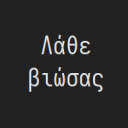The best source for the text of this work is the De Lacy translation available here. The appendix is excellent and should be read, if possible, before the work itself.
"On Methods of Inference" - Best Source for the Text And Getting Started
-
-
The beginning sections of the text are not preserved, and therefore we don't have the opening explanation for what the work is about in order to serve as a guideline for what follows.
Perhaps even worse, the work includes lots of repetition of positions that Philodemus is arguing *against*, so it's necessary to know beforehand which side of the argument Philodemus is taking so that you know if he's talking about his side, or that of the (largely stoic) enemy.
And perhaps even worst of all, the Epicurean arguments are so unknown to us that it takes considerable explanation to understand the Epicurean side of things before getting started.
So for that reason I strongly recommend reading the introductory material, and the appendix, before reading the text itself. Of course that means we're relying on DeLacey, and we have to be careful about that too, but it's better than starting at the beginning and reading pages and pages of dense material and only finding out afterward that you've started in a section giving the Stoic argument and that Philodemus himself doesn't agree with anything that you've just read.
Here are some links to the sections to read first. Every one of these contains valuable information that will help tremendously if you read it before reading the text.
-
Here is a slightly reformatted version of De Lacy's work. Counter arguments are in red, Epicurean arguments (mostly from Zeno of Sidon and Demetrius of Laconia) in black, with explanatory section titles. Not complete and still has some typos.
-
Quote
the person in Crete who was forty-eight cubits tall, according to those who examined the bones that were found
I wonder if they found dinosaur or ancient mammal bones. There was a Deinotherium (prehistoric elephant) fossil on the Greek island of Crete found in modern times.
-
Yes they were finding those elephant bones in antiquity as well. The large space in the center of an elephant's skull where the trunk attaches was figured to be the place for a single large eye of the cyclops.
-
Yes they were finding those elephant bones in antiquity as well. The large space in the center of an elephant's skull where the trunk attaches was figured to be the place for a single large eye of the cyclops.
I cannot find the evidence I thought I had for this statement! Perhaps it is a speculation.
-
Lo and behold, there's a book on this very topic:
The First Fossil HuntersThe fascinating story of how the fossils of dinosaurs, mammoths, and other extinct animals influenced some of the most spectacular creatures of classical…press.princeton.edu -
Of course, elephant bones were present and recognized as such by those who were familiar with them.
I recently was thinking about "elephantos, India quorum milibus e multis vallo munitur eburno" "Elephants, many thousands of which fortify India with an ivory wall " (DRN 2.537), I always thought this "wall" was just poetic. I still do, but there is this:
Dio Chrysostrom (Discourse 79.4) “Again, if ivory is a marvelous possession and worth fighting for, the Indians are of all men most blest and pre-eminent by far, for in their land the bones of the elephants are tossed aside and no one troubles to go near them, just as in our land the bones of cattle and of asses are treated; they even say that in many places the skulls of the elephants, tusks and all, are built into their house walls”
-
"Elephants, many thousands of which fortify India with an ivory wall " (DRN 2.537)
Is that a metaphor for using elephant-mounted troops in warfare? Like Themistocles interpreting "wooden walls" as ships.
-
Is that a metaphor for using elephant-mounted troops in warfare?
Yes I agree that war elephants are the main thing -- and probably the only thing -- that Lucretius is referring to. But the Dio Chrysostrom quote had me thinking for the first time perhaps there could be a bit more to it. We know that frozen Mammoth tusk huts are some of the oldest architecture discovered... Maybe there was a time in India when Elephants were as common as buffalo were in the Great Plains 150 years ago, and their bones were really so common that they became part of the architecture for some tribes for awhile.
This is all wild speculation. The climate in India would not preserve this, so the signs from which we can infer are few.
Unread Threads
-
- Title
- Replies
- Last Reply
-
-

-
Evidence of Survivors of Pompeii and Herculaneum 1
- kochiekoch
November 20, 2024 at 5:05 PM - General Discussion
- kochiekoch
November 20, 2024 at 8:17 PM
-
- Replies
- 1
- Views
- 90
1
-
-
-

-
“Better to lose the money because of me than to lose me because of the money.” 3
- TauPhi
November 19, 2024 at 7:57 PM - General Discussion
- TauPhi
November 19, 2024 at 9:30 PM
-
- Replies
- 3
- Views
- 213
3
-
-
-

-
An Anti-Epicurean Article - "The Meaning of Life Is Not Happiness" (For Future Reference) 12
- Cassius
November 9, 2024 at 8:07 AM - General Discussion
- Cassius
November 19, 2024 at 12:17 PM
-
- Replies
- 12
- Views
- 895
12
-
-
-

-
Was De Rerum Natura intended as satire? A lecture by THM Gellar-Goad. 14
- Julia
October 24, 2024 at 4:03 PM - General Discussion of "On The Nature of Things"
- Julia
November 11, 2024 at 4:09 PM
-
- Replies
- 14
- Views
- 1.1k
14
-
-
-

-
New Slideshow: Nothing Comes From Nothing
- Cassius
November 10, 2024 at 3:51 PM - General Discussion
- Cassius
November 10, 2024 at 3:51 PM
-
- Replies
- 0
- Views
- 534
-

